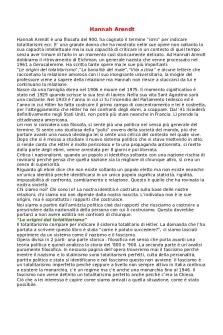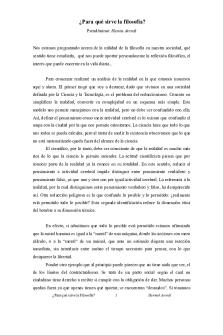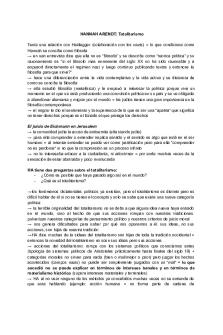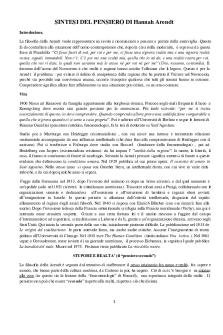Hannah Arendt summary civil disobedience PDF

| Title | Hannah Arendt summary civil disobedience |
|---|---|
| Author | Cynthia Olds |
| Course | History of Modern Philosophy |
| Institution | University of Pennsylvania |
| Pages | 2 |
| File Size | 56 KB |
| File Type | |
| Total Downloads | 8 |
| Total Views | 174 |
Summary
Download Hannah Arendt summary civil disobedience PDF
Description
Summaries Hannah Arendt, in her essay titled “Civil Disobedience” examines the origins, role, and effectiveness of civil disobedience in contemporary society. The author points out that civil disobedience to laws that some portion of the population finds offensive is effective as a way of getting laws to change. She notes that the models for civil disobedience are Athens’ great philosopher, Socrates and the New England Renaissance’s Henry David Thoreau. Their civil disobedience involved an enthusiastic embrace of the possibility of consequences in the form of punishment by the authorities. Arendt asserts that the United States legal system encourages each person to essentially try to change law by disobeying it. This is to some extent the result of the US situation that state laws may not agree with federal ones. I believe that an example of this potential conflict is to be found in the current case of laws addressing marijuana use, which may be quite permissive at the state or local level but are still very strict at the federal level. Hannah Arendt, however, focuses on the example of laws that were challenged during the civil-rights era. She points out that there were laws in Southern states that were inconsistent with Federal laws: “void” is the term she uses. She asserts that civil disobedience appeals to a higher form of law than the local (however local is defined). Arendt discusses the evolution of ambiguous legal responses to civil disobedience, starting from civil rights protesters, through to protesters against the Vietnam conflict, and, one could possibly add, the Occupy Wall Street movement. I believe that the author is suggesting that the stance of civil disobedience has been in some sense ‘normalized’, and concurrently the stance of the courts has become more punitive and hostile. Arendt points out that civil disobedients are seldom if ever singular – they are largely plural. This may be the case, as Arendt suggests, because only in large numbers can an action seem otherwise than either eccentricity or, for example, in the case of non-payment of taxes (which the
Amish withhold on pacifist grounds), personal greed. Arendt concludes by pointing out that effective civil disobedience will be clearly the result of concerted belief (for example, that Philadelphia school funding should be handled differently, or for the Green New Deal) rather than a desire to get out of class and jay walk at City Hall Plaza. This works best when numbers of people are in accord on an issue , suggesting perhaps that they will sooner or later vote for a politician who supports this stance. Arendt does not draw this rather cynical conclusion explicitly but it is hard to avoid. Katie Fitzpatrick offers a helpful analysis of Hannah Arendt’s influential 1970 essay on civil disobedience, titled “Change the world, not yourself, or how Arendt called out Thoreau”. This would have been the article to read, ideally, before trying to analyze and summarize Arendt’s piece. Fitzpatrick clarifies that Arendt was indeed drawing a very sharp distinction between individual protest, which Arendt terms conscientious objection, and mass protest, which she terms civil disobedience. Fitzpatrick also helpfully clarifies, for the reader who may not have studied Thoreau in detail recently, that Thoreau was breaking the law very much in the face of the community and as a public commentary on what he saw as immoral acts by the government in permitting slavery and taking up arms against Mexico. He was also a proponent of following only those laws that coincided with his personal beliefs. For Thoreau, even assenting to the results of a vote on some issue or another would force him to accept a decision that might not be congruent with his cherished beliefs....
Similar Free PDFs

Hannah Arendt - resumen libro
- 2 Pages

Hannah Arendt riassunto storia
- 6 Pages

Hannah arendt - asdfg
- 4 Pages

We refugees – Hannah Arendt
- 4 Pages

Civil Disobedience - Grade: B+
- 7 Pages

Civil Disobedience Movement
- 11 Pages

Civil Disobedience Movement
- 3 Pages
Popular Institutions
- Tinajero National High School - Annex
- Politeknik Caltex Riau
- Yokohama City University
- SGT University
- University of Al-Qadisiyah
- Divine Word College of Vigan
- Techniek College Rotterdam
- Universidade de Santiago
- Universiti Teknologi MARA Cawangan Johor Kampus Pasir Gudang
- Poltekkes Kemenkes Yogyakarta
- Baguio City National High School
- Colegio san marcos
- preparatoria uno
- Centro de Bachillerato Tecnológico Industrial y de Servicios No. 107
- Dalian Maritime University
- Quang Trung Secondary School
- Colegio Tecnológico en Informática
- Corporación Regional de Educación Superior
- Grupo CEDVA
- Dar Al Uloom University
- Centro de Estudios Preuniversitarios de la Universidad Nacional de Ingeniería
- 上智大学
- Aakash International School, Nuna Majara
- San Felipe Neri Catholic School
- Kang Chiao International School - New Taipei City
- Misamis Occidental National High School
- Institución Educativa Escuela Normal Juan Ladrilleros
- Kolehiyo ng Pantukan
- Batanes State College
- Instituto Continental
- Sekolah Menengah Kejuruan Kesehatan Kaltara (Tarakan)
- Colegio de La Inmaculada Concepcion - Cebu








